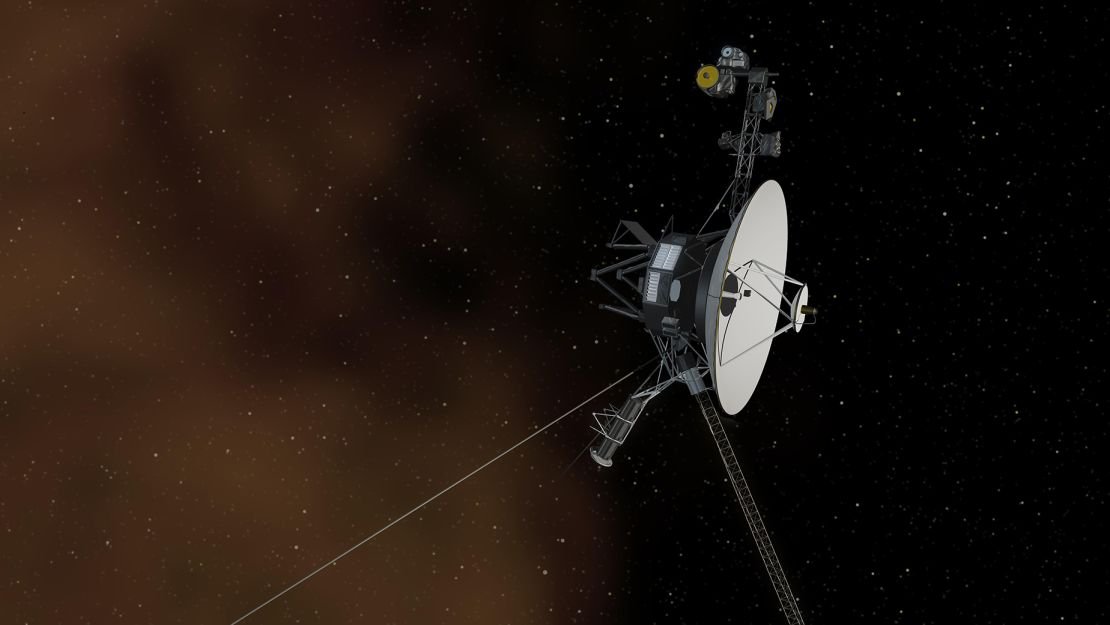Sign up for CNN’s Wonder Theory science newsletter. Explore the universe with news about fascinating discoveries, scientific advances and more.
CNN
–
NASA engineers have successfully fired the Voyager 1 thrust unit that has not been used in decades to solve a problem that could prevent the 47-year-old spacecraft from communicating with Earth from billions of miles away.
When Voyager 1 went up into space on September 5, 1977, no one expected that the probe would still be working today.
Because of its long-duration mission, Voyager 1 faces challenges as its extraterrestrial components reach beyond our solar system. When a problem arises, engineers at NASA’s Jet Propulsion Laboratory in Pasadena, California, must innovate while being careful how the spacecraft will react to any changes.
Currently the farthest spacecraft from Earth, Voyager 1 is about 15 billion kilometers (24 billion miles) away. The probe operates beyond the heliosphere – the sun’s bubble of gravity and particles that extend beyond Pluto’s orbit – where its instruments directly probe the interstellar region.
Earlier this year, engineers noticed a problem when a fuel pipe in one of Voyager’s spacecraft became clogged. If the thrusters are shut down, they cannot produce enough force to keep the spacecraft stable. Voyager’s thrusters keep the spacecraft oriented so it can communicate with Earth.
If Voyager 1 is not positioned so that its antenna is pointed at Earth, the spacecraft cannot “hear” commands from mission control or send data, according to Calla Cofield, media relations specialist at news at JPL.
“If the guns that keep the antenna pointed at Earth go off, that would be the end of the mission,” he said.
The team realized they would have to send commands to the spacecraft to switch to another set of thrusters, but the fix wouldn’t be easy.

This is not the first time Voyager 1 has needed to switch to another set of thrusters in recent decades. Fortunately, the spacecraft has three sets of thrusters: two sets of thrusters that actuate thrusters and one set that handles course correction.
Voyager 1 used thrusters for different purposes as it flew by planets like Jupiter and Saturn in 1979 and 1980, respectively.
Now, the spacecraft travels a constant path away from our home planet, so it only needs one set to help keep its antenna pointed at Earth. To fuel the thrusters, liquid hydrazine is turned into a gas and released about 40 times a day to keep Voyager 1 perfectly focused.
Over time, engineers discovered that the gasoline in the missiles could be blocked by silicon dioxide, which is produced by the aging of the rubber. As guns close, they produce less power.
In 2002, the team ordered Voyager 1 to switch to its second propulsion unit when the first unit showed signs of shutting down. Engineers switched again to the trajectory correction thruster installed in 2018 when the second set also appeared to be closed.
But when the team recently assessed Voyager’s correctional probes, they were more constrained than the previous two probe groups.
When the team first switched Voyager to correction probes six years ago, the tube opening was 0.01 inches (0.25 millimeters) wide. But now, the closure has been reduced to 0.0015 inches (0.035 millimeters) — half the width of a human hair, according to NASA.
It was time to go back to another group of influencers.
As Voyager 1 and its twin, Voyager 2, aged, the mission team slowly turned off unnecessary systems on both spacecraft to conserve power, including burners. As a result, Voyager 1’s components are now very cold, and the team knew they could not simply send a command to Voyager 1 to immediately switch to one of the thrusters without do something to warm them up.
But Voyager 1 doesn’t have enough power to turn on any heaters without turning off something else, and its scientific equipment is too critical to shut down if it doesn’t return, the team said.
After going back to the drawing board, the team realized they could shut down one of the spacecraft’s main heaters for about an hour, which would allow engineers to turn the heaters on and off. make the switch safely.
The plan worked, and by August 27, Voyager 1 was relying on one of its primary instruments to stay in touch with Earth.
The team has taken steps to use the thrusters less, and expects to get another two to three years out of the original set, said Todd Barber, Voyager’s propulsion engineer.
Once the spacecraft is exhausted, Voyager 1’s only remaining option is a closed set of boosters.
“All the decisions we will have to make going forward will require more analysis and caution than ever before,” said Suzanne Dodd, Voyager project manager, in a statement.
Voyager 2 also went through thruster swaps in 1999 and 2019, and “the conditions there are very weak,” Barber said. Voyager 2 traveled more than 20 billion kilometers from Earth.
The information collected by these long-term studies helps scientists learn about the comet-like structure of the heliosphere and how it protects the Earth from the strong particles and radiation of interstellar space.
#47yearold #Voyager #spacecraft #shot #objects #hasnt #decades #CNN
